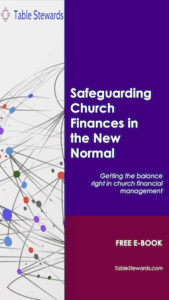Introduction
Churches and charities play a much-needed role in society, offering services to benefit humanity in a way no other sector of business or society does. This role becomes even more important as the world faces a global cost of living crisis.
The UN Development Programme reported that 71 million people in the developing world have fallen into poverty in just three months as a direct consequence of global food and energy price surges. And, the impact on poverty rates is drastically faster than the shock of the COVID-19 pandemic.
Similarly, in developed countries, the World Economic Forum reports that 1 in 4 people were struggling financially from the impact of the cost of living crisis.
The services provided by churches and charities are being called on more than ever before in the midst of the cost of living crisis and its knock-on impact on people’s lives.
Even then, churches and charities are also not immune from the effects of the cost of living crisis, as they are also operating in the midst of the global crisis.
Churches and charities therefore face the two-fold challenge of reaching out to help those in need more than ever before, whilst ensuring that they also can navigate through the cost of living crisis and continue to operate effectively.
This article takes you through what the cost of living crisis is, and explores seven ways that churches and charities can navigate through the cost of living crisis to remain effective in meeting the needs of those that depend on them, while efficiently staying afloat.
Table Stewards uses a light-hearted scene setting approach to introduce its topics, but if you would prefer to dive straight into any part of the article, please click the relevant link in the table of contents above.
Scene Setting
The Learning & Development Committee are having their pre-meeting with Coach Emmanuel before the masterclass.
Brother Badtrus: Where are going with this inflation?! Just stopped at the local store for some fruits, and I couldn’t believe the price increase. It is hitting on every side – food, fuel, energy and everything essential!
Elder Sam: I know! I was just discussing the unbelievable contract price increases on the church security services contract, with no change in level of service.
Brother Badtrus: I guess we have no choice but to accept the price increases as there is inflation everywhere!
Sister Jane: Don’t you think we should ask the procurement department to test the market first and find better value options instead of just accepting the price increases.
Elder Sam: But, they have been our service providers from over 10 years and we have not had any issues.
Sister Mary: What if all other suppliers increase their prices, that will definitely bust our budgets and limit funds available for operations and charitable activities. Inflation could also affect people’s giving leading to a double whammy of increased expenditure and reduced income!
Coach Emmanuel: You are right. The cost of living crisis is affecting individuals and organisations alike. But there are steps churches and charities can take to navigate through the crisis and still operate efficiently. Let’s examine them in the masterclass!
What is the Cost of Living Crisis?
Inflation has soared to record levels across the world resulting in what is termed as the cost of living crisis.
A cost of living crisis simply describes a scenario when the cost of everyday essentials is rising at a level where average incomes cannot keep up. Such essentials include food, energy, fuel, and housing costs (rent or mortgage).
The rising inflation is driven by a combination of the knock-on effect of the COVID-19 pandemic, the war in Ukraine, and increasing global instability.
This has led to scarcity from supply chain disruptions and labour shortages driving rising prices of essentials; soaring energy prices as demand exceeds supply; and rising food prices.
For your church or charity, the rise in the cost of living can play out in higher energy bills, fuel and transportation costs, higher expenditure, contractual costs, and facilities maintenance costs.
You may also notice a reduction in income as givers feel the impact of the cost of living crisis in their individual lives.
You could also see a rise in the call on your charitable services by those feeling the pinch of the crisis e.g. for assistance with food, bills and housing.
How to navigate the cost of living crisis
So how do churches and charities navigate the cost of living crisis? Here are seven areas that your church or charity should look into:
Review your Expenditure Budget
As a minimum, your priority should be to maintain the quality of your services. But you want to do so by only spending on what is necessary and at the best value for your money.
You therefore need to review all aspects of your expenditure budget and explore how you can cut costs or get better value for money out of your expenditure.
Suppliers. One area to explore is regular suppliers. You may have been using the same suppliers for a long time without checking whether they are still offering the best prices in the market.
As businesses are striving to survive and retain customers in the economic climate, prices are getting more competitive.
Now is the time to negotiate with suppliers for more competitive prices or to shop around for better deals.
Contracts. The same applies to contracts that are coming to an end. Don’t just extend or renew contracts without checking the market for better deals and terms and conditions.
Ensure that the terms and conditions of your contracts provide the opportunity to periodically test the market and break out of the contract when it is no longer offering best value for money.
Energy costs. Look at ways to reduce energy use and make your buildings more energy efficient.
Switch gas and electricity suppliers to a cheaper deal, and consider cutting down on the amount of energy you use by switching off lights or reducing heating in empty rooms.
Travel costs. Travel costs can be a major expense for churches and charities, depending on their operating model.
You can reduce travel costs by using technology to your advantage. For example, you can hold meetings virtually using video conferencing platforms instead of traveling to meet in person.
Where travel is necessary, you can take advantage of discounts as many churches and charities qualify for discounts on travel expenses.
Check for any available charity sector discounts when booking travel arrangements or use travel agents that can ensure that you get charity discounted travel prices.
Service costs. Review all the services that your church or charity provides to members, beneficiaries and the public.
If you are offering a service that is not in demand or delivering real benefit, consider discontinuing it.
Review your Staffing Levels
Staff costs are one of the major costs in organisational budgets. Over-staffing can lead to inefficiencies and waste.
You want to ensure that your staffing levels represent what you really need to run your church or charity efficiently. This doesn’t always mean letting go of staff.
You can review roles and responsibilities and make sure that staff are fully utilised to cover your core services, so that you are not recruiting inefficiently.
On the other hand, you may need to let go of any surplus staffing to save on costs and operate more efficiently.
Also consider maximising the use of volunteers where you only have to cover their expenses, as this may be an alternative for some self-contained tasks.
Review your Internal Controls
Reports show that fraud is on the rise, further exacerbated by the cost of living crisis.
The temptation, motivation and opportunity for fraud has never been greater.
Churches and charities need to be extra vigilant to the fraud risk and strengthen internal controls to mitigate against the risk.
With sound internal controls, you can deter fraudulent activities in your church or charity operations.
However, internal controls need to be periodically reviewed to ensure they remain relevant and sound, especially when there are significant changes in processes or personnel.
The key internal control of segregation of duties should always be a primary consideration in all your church or charity processes.
Additionally, ensure you have sound processes that help ensure the following:
- Accurate accounting for income and banking cash intact.
- Welfare financial assistance is budgeted for, authorised and disbursed to verified beneficiaries in line with scope and eligibility criteria.
- Authorisation of purchases and payments at the right levels in the organisation.
- Clear policy and monitoring arrangements for incurring expenses.
- Staff and volunteers are educated on the signs of fraud and what to do if they suspect something is not right.
Consider Sharing Resources
Sharing of resources can be a great way to reduce costs and use resources more efficiently.
If your church or charity has more than one location, you can consolidate your administration and back-office functions e.g. finance, in one location for more efficient use of resources i.e. staff, office space, and equipment.
As well as reducing costs, it can also lead to increased efficiency and effectiveness, and improved quality of service for beneficiaries.
You can also share resources with other churches or charities by opening up unused spaces such as halls for hire or extra car parking spaces.
By doing so, you would be supporting the good causes of other organisations, while making some ancillary income.
However, you would need to be sure that such organisations have values and ethos that are compatible with yours, and that you can maintain good working relationships.
Make the most of Digital and Technology Platforms
Digital and Technology platforms can help cut the costs of labour intensive administration.
Using online giving platforms can help reduce staffing costs and time in otherwise labour intensive income processing activities.
Additionally, you can save advertising costs by effectively using social media and messaging platforms to reach your members and beneficiaries.
Your mission, values and programmes will determine your choices of where to use technology to save on costs.
For example, an evangelistic outreach may mean that you need to print materials for physical engagement with people, rather than use social media.
However, every church and charity can benefit from using digital and technology driven online giving platforms to increase their reach and income.
Review where your church or charity can most benefit from taking advantage of digital and technology platforms.
Embark on targeted Outreach Programmes
The cost of living crisis is a great opportunity your church or charity to promote its mission and good causes by providing more services to those in need.
This could include food banks, clothing, reduced-cost childcare, welfare financial assistance or financial counselling.
You can also signpost people to other charities that can support them in areas that your church or charity does not provide services e.g. specialised support for the elderly.
Helping people get back on their feet is also a useful means of supporting those adversely affected by the cost of living crisis.
You can do this by providing employment-focussed learning and re-skilling opportunities directly or in partnership with accredited organisations.
This may mean revisiting your budget for good causes to ensure you allocate funds for your response to the cost of living crisis.
The rewards of outreach, value-adding interventions and demonstrable relevance to the community can outweigh any costs.
By helping beneficiaries back into employment or business, your church or charity will eventually reap the benefits as those beneficiaries also want to give back.
Mitigate against Income Loss
Making sure your church or charity does not lose income is another way of weathering the cost of living crisis.
By being intentional about mitigating against income loss, you can not only preserve the income levels of your church or charity, but even grow your income in spite of the crisis.
For ways to mitigate against income loss, read our article on 6 ways to keep your church or charity from losing income.
Conclusion
Churches and charities are not immune from the cost of living crisis.
However they can successfully navigate through by taking appropriate steps.
These include to reviewing their costs, ensuring appropriate internal controls, guarding against income loss, and making the most of technology to reduce costs.
It is also a good opportunity to foster their core mission and good causes, reaching out to help individuals adversely affected by the cost of living crisis, ensuring that they and their communities can weather the storm.
Also, read our articles on:
- why churches need good internal controls,
- How segregation of duties protects church finances
- How to prevent internal control failure in churches and charities
- Online giving platforms – how to manage risks to data and finances
- How to create a business continuity plan for your church or charity








